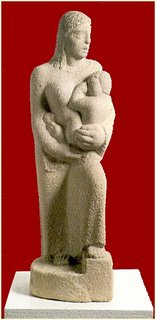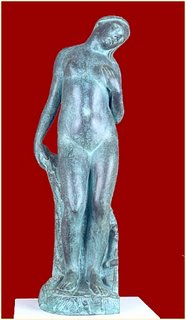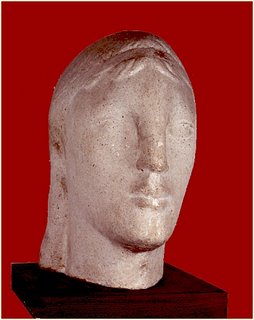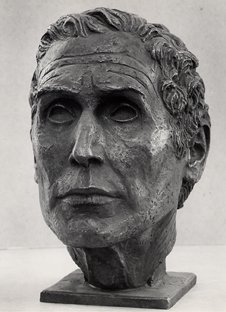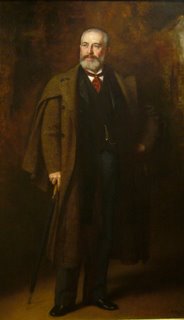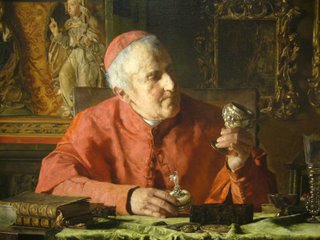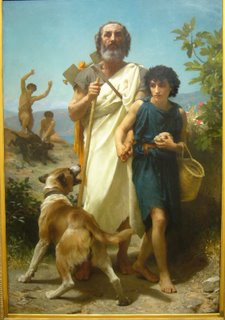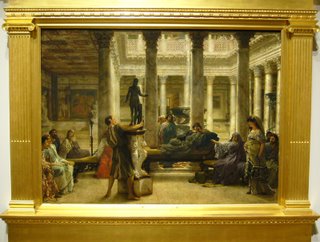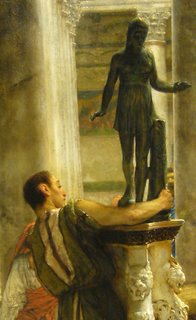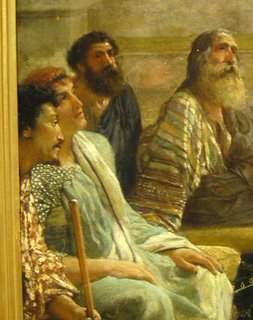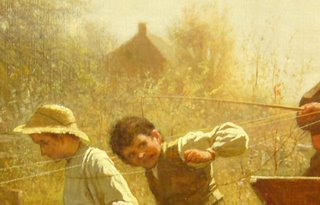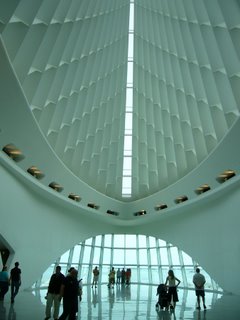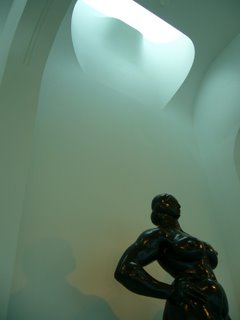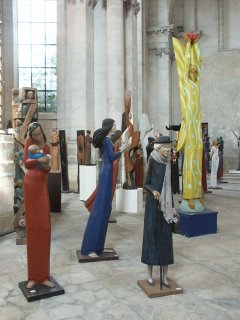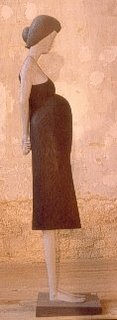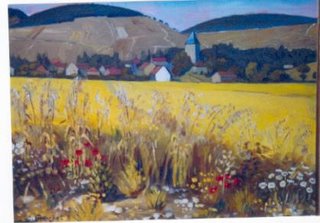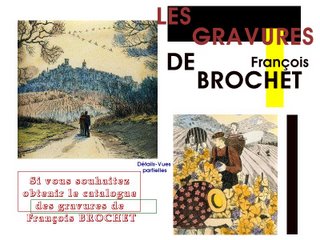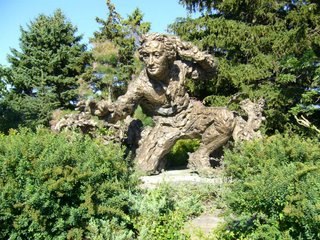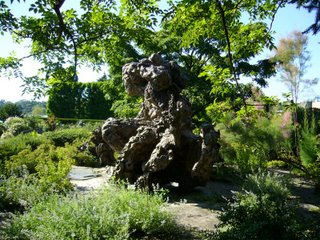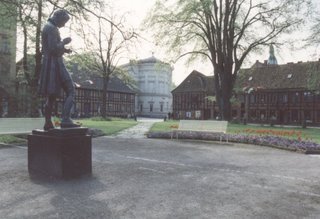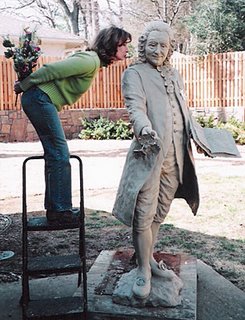
One of the benefits of working a record shop is meeting music lovers -- and Bud Schreiner was a lover of many things -- including Wagner, Italian opera, and liturgical Russian singing.
And he was also an artist-- or maybe art-bum is the better word -- i.e. one whose obsession with the visual arts precludes the pursuit of a middle-class career.
I enjoyed his good-natured banter -- the trips to his basement studio -- his collection of German drinking mugs, and some trips we made to a few local Russian churches to see the icons. But I especially enjoyed myself through his eyes. For some reason, he picked me out as a person to like -- and who am I to question his taste in friends ?
And now he's gone -- to wherever it is such souls end up going.
His drawing at the top depicts (if I recall correctly) the Virgin Mary at the moment of the Annunciation. He gave it to me several years ago -- and I guess I kept it for such a moment as this (although the time spent in my studio has not been kind to it)
It's got a lot of kick, doesn't it ? If the paintings in American churches had that much spirit -- who knows -- I might have joined one.
.............................................
below is an obituary lifted from the Chicago Tribune -- telling me much more than I ever knew about this charming man
............................................
Henry Louis "Bud" Schreiner 1931-2006 Artist's talents spanned many fields
By Aamer Madhani
Tribune staff reporter
Published July 21, 2006
Bud Schreiner was the type of guy who was as comfortable strumming his banjo on his front porch as he was engaging his parish priest in a deep spiritual conversation.
His family recalled him as unusually gifted: Mr. Schreiner could boot a football 95 yards off a tee, paint portraits that mimicked the style of the Dutch artist Vermeer and sing Wagner and Verdi operas in a peerless tenor.
Henry Louis "Bud" Schreiner Jr., 74, a former pharmaceuticals salesman and alcohol-abuse counselor, died of complications from brain cancer Wednesday, July 12, at his home in Riverside.
Mr. Schreiner, who also painted commissioned portraits of local celebrities and tycoons, lived much of his life in the city's Edgewater neighborhood, where he was well known on his block for leading the neighborhood kids in singalongs of "Puff the Magic Dragon" and "Michael, Row the Boat Ashore." He was also a regular at the now shuttered Earl of Old Town, where he would play his banjo with other regulars at open-mike nights.
He was also remembered in his neighborhood for his ability to kick a football as far as many NFL place kickers, said his son Chris.
"He would bring an orange tee and five footballs and have us kids run the footballs back to him," his son said. "We loved it."
At one point, Mr. Schreiner had even attracted the attention of some NFL scouts, his son said.
Mr. Schreiner attended the American Academy of Art in Chicago as well as the Art Institute of Chicago. For many years, he painted commission portraits in the attic of his home, his son said. He also took a particular interest in painting religious-themed works, several which are on display at various Catholic churches in the city, his son said.
Mr. Schreiner was active in the St. Gertrude Catholic Parish choir and a member of the Chicago German Choir for many years.
He was married in 1957 to Therese Marie Indelli, with whom he had six children. They divorced, and he later married Judy Kohut.
His daughter Susan O'Toole-Corbett, said she was always impressed with how varied his talents were, but she was most struck by his ability to make each of his family members feel special.
She recalled a moment many years ago when her father took her and her other siblings to a toy store. She remembered eyeing a doll that she wanted, but she didn't ask for it because she knew her father couldn't afford it. Her father gave her a gift of a doll a few years ago, she said.
"He had remembered all those years that I wanted it," she said.
Other survivors include two more sons, Mark and Steven; two more daughters, Beth-Ann Born and Julie Gombas; a sister, Deloris Snyders;. 15 grandchildren and several nieces and nephews.
Below is a eulogy written for the memorial service by Tom Murphy:
Bud and Tom at the Brookfield zoo
My name is Tom Murphy.
Many of you know me, but for those that don't, I've known Bud for over thirty years and been his friend. .
Judy reminded me that Bud and I met one another on the steps of St. Gertrudes. I have a hard time remembering that detail in that the Church and I didn't have much to say to one another in those days.
There was a whole lot of spectacular bad behavior back then, so I might have been atoning for some.
Bud, I came to learn, was a most devout Church goer.
I preferred relying on last minute repentance and God's infinite forgiveness. So I rarely made it past the front door.
As it turns out, Bud and I shared some very hard challenges in those early years, and I must say that I doubt I could have overcome them without his support.
Yet difficult times can fuse a closeness if they're shared.
Thus, a friendship...a kinship was formed and has lasted all these years.
Its said: "Two may talk together under the same roof for many years, but really never meet; and two others at first speech are. old friends."
So here's two guys from the neighborhood...close to' the same age with different backgrounds...different public lives. Some shared opinions...many divergent thoughts. One profoundly religious...the other hopelessly sinful and unrepentant. But we shared a common sense of humor and would often recount that it was this that saved us from ourselves.
, .
But we liked to talk...and talk we did for over thirty years with only a few interruptions. Once when I moved out of state for a short time and another time when we were angry at one another over an issue I can't recall. That's how important it was. Whatever that issue was, it wasn't as important as listening to the sounds of our own voices.
So the sound machine was turned on again.
He would talk of the sadness he felt at people's lack of kindness and civility and wondered why. It bothered him a lot.
He would talk of the Church and its never ending battle with the Vatican. He would insist that Chicago politics will never be cleaned up.
Both of us hopeless Cub fans, he would wonder if they would ever win the World Series in his lifetime. Sorry Bud...but not in my lifetime either.
And so we went on talking and then talked some more. Never at a loss for an opinion...either one of us.
Myself and my opinions in simple declarations...rarely a compound sentence.
Bud, on the other hand, expressed everything in metaphor. Not to intentionally confuse me, but rather to force me to think of the subject a little more deeply...more completely.
There's a picture up front here that is accurate in every detail. It says it all. If it had a caption it would be me saying: "Bud, I don't know what you're talking about." And if there was a following frame it would be Bud patiently connecting all the dots for me and explaining what he meant to my creatively challenged mind.
So Bud was multi-dimensional in his understanding of what life was all about. He expressed thoughts using historical, mystical and pop culture references. It seemed perfectly reasonable to contrast Dusty Baker and his Cubs to Moses and his followers wandering the desert. It just wasn't enough to know that they stunk up the place and didn't have a lead-off man. It was required that I appreciate the cultural and symbolic dynamic of why they're so lousy.
And so our conversations were trips...journeys really. Bud at a steady conversational pace weaving his metaphors...me stumbling along side trying hard to keep up. It was hard work...but worth it.
As I came to know Bud over the many years, I began to understand that his negotiations with his work, his family and with life itself straddled several universes at once. Of course there was his art. His painting and sculpture...all evoking a feel for another age and another time. But all with the loving detail and craft that was his life.
Judy, his children, his friends...all benefited from his appreciation for this detail for life. Bud would worry about them. Become frustrated with them. Boast of their accomplishments. Become heartbroken for them and then laugh with them.
But most of all he loved them with the care and attention only he could bring them. "
His family, his friends, all that he loved were his working canvas.
Sanctifying your memory would be to miss out on the core of your being. Your mischievous sense of humor...your wit and creative talent, always
probing and. looking for answers..Your humility and your desire to do good for others as a release from your misplaced feelings of unworthiness.
To Eulogize: a formal speech of high praise for someone who's passed away.
I know few people who had more to give all of us and did...than Bud.
His love and good humor...his loyalty and simple courage...and because of his genuine humility would be squirming in the pew were he with us today. I give thanks for his life and I'm proud to call him friend.
Bud told me several weeks before his death that I shouldn't worry...that he . wouldn't stop talking to me...ever. I told him that was OK by me as long as he didn't leap out of a dark closet. He grinned and found that amusing. I did too.
One of his girls told me a few weeks ago that in spite of her sadness over
her father, it gave her some comfort to know that he would be welcomed by a deceased loved one when his journey was over.
I too have a vision that Bud has already located a park bench for us and,
whenever my time comes, we can take up those great conversations where we left off. .
No heavenly choirs...no golden robes or harps. Just a whole lot of great talk. Some serious...some profound...some just silly. That thought gives me comfort.
I'm reminded of a verse that Bud could have written:
"In a dream I walked with God through the deep places of creation; past
walls that receded and gates that opened, through hall after hall of silence, darkness and refreshment-the dwelling place of souls acquainted with light and warmth-until around me was an infinity into which we all flowed together and lived again."
What we have deeply loved
we can never lose.
For all we love deeply
Becomes a part of us.

